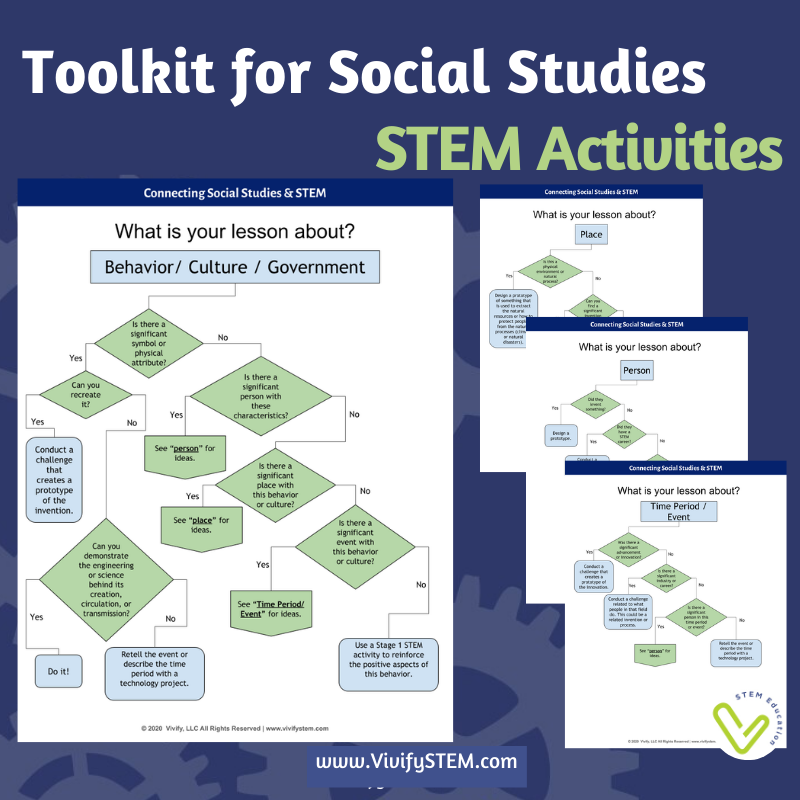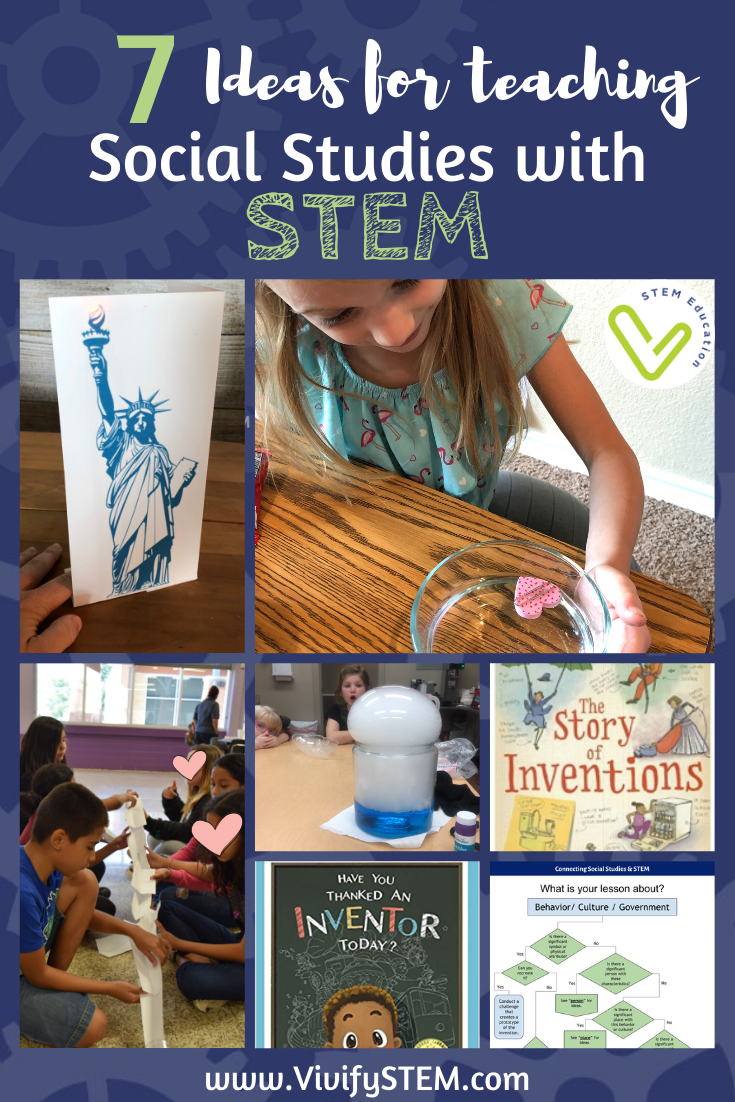7 Ideas for Teaching Social Studies with STEM
By Claire Meschkat
Originally Posted: July 11, 2020
Updated: April 2025
STEM, by definition, is a collaborative way of bringing subjects together to introduce students to higher-order thinking. So it shouldn’t be isolated to the science or specials classes. Bring STEM into your social studies lessons with the ideas and tips below.
** This post contains affiliate links
1. Set the Stage with a STEM Hook
You know that kids are naturally curious. Pique their interest with a science demo that draws them into a deeper understanding and memorable experience with your social studies concept. For example, I did dry ice experiments (PDF for this here) with my students when talking about Antarctica. We discussed the 3 states of matter as we watched the dry ice sublimate underwater and also talked about the cold climate of Antarctica and how scientists, researchers, and other people who live there have to adapt to the environment to protect themselves. You can find the whole lesson that also includes an engineering design challenge to build an insulating shelter linked below. You can also tie in government by discussing how Antarctica is governed by a treaty instead of being owned by one nation. Discuss potential problems and how your students think the continent should be run.
Maybe you will be talking about landforms and how volcanoes affect people and history. Start the class off with a classic baking soda and vinegar volcanic eruption out of a bottle! Find science experiments that can be simple displays to intrigue your students and whet their pallet for your social studies lesson.
2. Break the Ice with STEM
Involve foundational STEM skills such as teamwork, critical thinking, and perseverance when setting up for your social studies lesson. Consider doing what we call icebreaker challenges to strengthen these skills. For example, the pipeline challenge uses paper, PVC pipes, or cardboard tubes to make a pipeline. The goal is for each student to have a section of the pipeline and they must work together with the entire class to get a ball to continuously roll in the pipeline from one end of the room to the other. The ball can only roll and cannot be transported by students’ movement (no holding the ball in their section of the pipeline while they walk). Use this activity to talk about transportation and the advancement of the railroad or to open discussions about the migration of people groups. Discuss the significance of an assembly line in speeding up processes and how everything must be timed perfectly and working together to be successful. For more ideas on these types of activities that you could tie into your social studies lessons, see our post on icebreakers or check out our huge bundle of 50 icebreakers.
3. Interact with Maps
Enliven your social studies lessons by creating a tool to explore maps beyond staring at a page in a book or poster on the wall. When learning about maps or geography, I first have my students make their own compass. To create a compass, follow these instructions:
Supplies:
a small bowl of water
something that floats (a piece of foam, cork, or plastic)
paperclip
magnet
Place your small floating object on the surface of the water, making sure it is small enough to rotate freely in the center of the bowl. Using your magnet, rub the paperclip in one direction across it about 50 times. It is very important that you only rub it across the magnet in one direction and not back and forth. Without touching anything else, carefully place the paperclip onto the floating object. Now watch it spin until the paperclip orients itself North & South. Cool right? Mark which end of the paperclip points north.
Once your students have a working compass, assign student teams different mystery locations on a map or throughout your room. Provide them clues to where their mystery locations are by giving them a map and telling them how they relate to different cities using the cardinal directions and a distance. You can do this in your classroom by putting sticky notes with real or made-up names scattered throughout the room and have them navigate using their compass. The clues would read something like, “You are south of Dallas, Texas” and “You are West of Shreveport, Louisiana.” Teach them about the history of orienteering and the compass!
4. Create before You Compare and Contrast
Use the engineering design process to recreate instruments, homes, or tools from the different people groups or time periods throughout history. This helps students relate to what they are comparing and understand the depth of differences and similarities.
It is important to note that engineering design challenges must accomplish one or both of the following: The design must solve a problem, or make something better. Engineering design challenges follow the engineering design process and are not just a craft project. If this effort is beyond the scope of your classroom, consider making the projects a collaborative endeavor between various departments. STEM is all about subject integration, so ask the science, math, and technology teachers to work together in teaching and conducting these activities. Need more help tying in a STEM challenge? See the next point below!
5. Connect with a Design Challenge
Incorporating a design challenge helps students not just identify significant people and things, but to also identify WITH them. And hopefully feel moved to use their problem-solving skills to help care for others in this world.
You may be thinking, how do I come up with design challenges?!? We’ve made that easy for you with a toolkit. Grab our free flow-chart located in our free resource library!
This flow-chart will help you brainstorm and design engineering STEM challenges to connect to any social studies topic. For example, when you are discussing the government, you will start on the “behavior, culture or government chart”. Maybe you want to talk about the United States Government. The flow-chart asks “Is there a significant symbol or physical attribute?” Sure, the Statue of Liberty. The flow-chart asks, “Can you recreate it?” Sure, let’s make a STEM challenge to make a prototype of the Statue of Liberty. Remember that an engineering design challenge solves a problem or makes something better. If we made a small Statue of Liberty, we could add constraints to require that it needs to stand up on its own and have a torch that lights up! We can incorporate electricity and circuits by making this a paper circuit Statue of Liberty that lights up. Use copper tape, a coin cell battery, and an LED to make a torch that lights up then make your statue such that it stands up while supporting its light.
Speaking of copper tape, explain to your students how the Statue of Liberty was a gift from the French and that it is made out of copper. The copper used to be a shiny brown color like a penny but over time the copper reacted with the air to turn green. You can also do a science demo to turn pennies green similar to the Statue of Liberty by adding vinegar and salt to some old pennies and letting them set out for a few hours. The science: Turning a penny green does not eat holes into the penny. When you add vinegar and salt, it dissolves the top copper-oxide layer of the penny. This causes the copper atoms to mix with oxygen in the air and chlorine in the salt. This creates a blue-green substance layer called patina.
You may get to a lesson where a design challenge does not fit into the scope of the topic like an event or time period without a prominent person, industry, or innovation. Consider having your students use technology to retell or describe the topic.
Do a green screen reading of historical works of literature
Make a musical instrument and play cultural or historically significant songs.
Use stop motion animation to act out an important event or celebration
Include Virtual Reality tours of military museums or the international space station.
Telling STEM through a story is a great way to get kids engaged in STEM challenges! Learn more here or see more of our favorite books in the Vivify STEM Amazon Storefront!
6. Read Historical Invention Books
Connect to historical inventions by reading books about the amazing engineers, scientists, and entrepreneurs in our past that have impacted our lives with their perseverance and problem-solving skills. Talk about the inventions and the characteristics of the inventors. You can even create prototypes of the inventions with an engineering design challenge. Look at a map also and pinpoint where the invention originated. Here is a list of our favorite history of inventions books to check out:
The Story of Inventions by Anna Claybourne
Mr. Ferris and His Wheel by Kathryn Gibbs Davis
The Boo-Boos That Changed the World by Barry Wittenstein
Gary and the Great Inventors by Akura Marshall
The Crayon Man: The True Story of the Invention of Crayola Crayons by Natascha Biebow
Woosh!: Lonnie Johnson's Super-Soaking stream of Inventions by Chris Barton
Girls Think of Everything: Stories of Ingenious Inventions by Women by Catherine Thimmesh
How the Cookie Crumbled: The True (and Not-So-True) Stories of the Invention of the Chocolate Chip Cookie by Gilbert Ford
Pop!: The Invention of Bubble Gum by Meghan McCarthy
Have You Thanked an Inventor Today? by Patrice McLaurin
Find more STEM books here: bit.ly/Vivifystembooks
7. Connect to Real-World Resources
Aside from researching different topics and recreating designs, reach out to the professional experts to complement your social studies lessons.
Look for national societies related to the topic you are teaching on. They may have free resources, activities, or demonstrations that can aid in the engagement of your lessons.
Get guest speakers to come in and talk to your students about their jobs or organizations as they relate to what you are learning. Emphasize how STEM careers aid in helping society and our planet. Talk about organizations such as Engineers Without Borders that go beyond their jobs to help people with their engineering skills by providing access to clean water in remote villages. If your students are able to meet with the professionals in person or digitally, help them ask them meaningful questions about the challenges of their career, the things they learn from school in their job, and how they help others with what they know. Check out our free guide with interview questions for your students to ask STEM professionals.
We hope this helps boost engagement with your social studies lesson! Let us know what other ideas you have of incorporating social studies and STEM in the comments.
Ready to go on a social studies adventure? Vivify proudly presents STEM Explorers - a curriculum for elementary students truly embodies that spirit by connecting engineering design challenges to history and geography while also including math and science! The mission: to explore all seven continents and discover the inventions that were born there! Are you ready?
**Vivify STEM, LLC is a participant in the Amazon Services LLC Associates Program, an affiliate advertising program designed to provide a means for us to earn fees by linking to Amazon.com and affiliated sites. This post contains affiliate links and any purchases are no extra cost to you.










